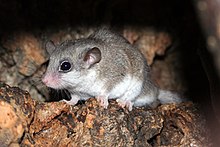Myoxidae
| Dormice Temporal range: Early Eocene–Recent |
|
|---|---|
 |
|
| African dormouse, Graphiurus sp. | |
| Scientific classification | |
| Kingdom: | Animalia |
| Phylum: | Chordata |
| Class: | Mammalia |
| Order: | Rodentia |
| Suborder: | Sciuromorpha |
| Family: |
Gliridae Muirhead in Brewster, 1819 |
| Subfamilies and genera | |
The dormouse is a rodent of the family Gliridae (this family is also variously called Myoxidae or Muscardinidae by different taxonomists). Dormice are mostly found in Europe, although some species live in Africa or Asia. They are particularly known for their long periods of hibernation. As only one species of dormouse is native to the British Isles, in everyday English usage "dormouse" can refer either to that one species (the hazel dormouse) or to the family as a whole.
Dormice are small rodents, with body lengths between 6 and 19 cm (2.4 and 7.5 in), and weights between 15 and 180 g (0.53 and 6.35 oz). They are generally mouse-like in appearance, but with furred, rather than scaly, tails. They are largely arboreal, agile, and well adapted to climbing. Most species are nocturnal. Dormice have an excellent sense of hearing and signal each other with a variety of vocalisations.
Dormice are omnivorous, typically feeding on fruits, berries, flowers, nuts, and insects. They are unique among rodents in that they lack a cecum, a part of the gut used in other species to ferment vegetable matter. Their dental formula is similar to that of squirrels, although they often lack premolars:
Dormice breed once or occasionally twice each year, producing litters with an average of four young after a gestation period of 22–24 days. They can live for as long as five years. The young are born hairless and helpless, and their eyes do not open until about 18 days after birth. They typically become sexually mature after the end of their first hibernation. Dormice live in small family groups, with home ranges that vary widely between species and depend on the availability of food.
...
Wikipedia
